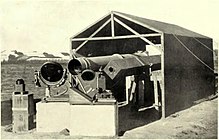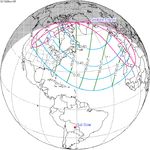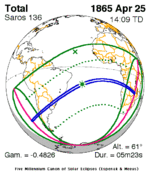
Astronomer Royal is a senior post in the Royal Households of the United Kingdom. There are two officers, the senior being the astronomer royal dating from 22 June 1675; the junior is the astronomer royal for Scotland dating from 1834. The Astronomer Royal works to make observations to improve navigation, cartography, instrument design, and applications of geomagnetism. The position was created with the overall goal of discovering a way to determine longitude at sea when out of sight of land.
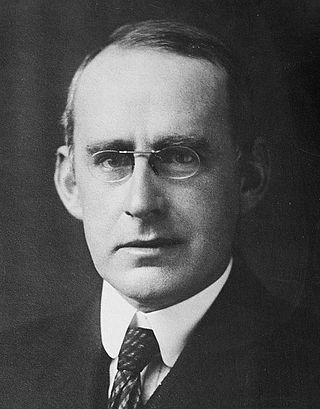
Sir Arthur Stanley Eddington was an English astronomer, physicist, and mathematician. He was also a philosopher of science and a populariser of science. The Eddington limit, the natural limit to the luminosity of stars, or the radiation generated by accretion onto a compact object, is named in his honour.

In physics, gravity (from Latin gravitas 'weight') is a fundamental interaction which causes mutual attraction between all things that have mass. Gravity is, by far, the weakest of the four fundamental interactions, approximately 1038 times weaker than the strong interaction, 1036 times weaker than the electromagnetic force and 1029 times weaker than the weak interaction. As a result, it has no significant influence at the level of subatomic particles. However, gravity is the most significant interaction between objects at the macroscopic scale, and it determines the motion of planets, stars, galaxies, and even light.

Vulcan was a theorized planet that some pre-20th century astronomers thought existed in an orbit between Mercury and the Sun. Speculation about, and even purported observations of, intermercurial bodies or planets date back to the beginning of the 17th century. The case for their probable existence was bolstered by the support of the French mathematician Urbain Le Verrier, who had predicted the existence of Neptune using disturbances in the orbit of Uranus. By 1859 he had confirmed unexplained peculiarities in Mercury's orbit and predicted that they had to be the result of the gravitational influence of another unknown nearby planet or series of asteroids. A French amateur astronomer's report that he had observed an object passing in front of the Sun that same year led Le Verrier to announce that the long sought after planet, which he gave the name Vulcan, had been discovered at last.

A gravitational lens is matter, such as a cluster of galaxies or a point particle, that bends light from a distant source as it travels toward an observer. The amount of gravitational lensing is described by Albert Einstein's general theory of relativity. If light is treated as corpuscles travelling at the speed of light, Newtonian physics also predicts the bending of light, but only half of that predicted by general relativity.

Sir Frank Watson Dyson, KBE, FRS, FRSE was an English astronomer and the ninth Astronomer Royal who is remembered today largely for introducing time signals ("pips") from Greenwich, England, and for the role he played in proving Einstein's theory of general relativity.
The year 1919 in science and technology involved some significant events, listed below.

Erwin Finlay-Freundlich was a German astronomer, a pupil of Felix Klein. Freundlich was a working associate of Albert Einstein and introduced experiments for which the general theory of relativity could be tested by astronomical observations based on the gravitational redshift.

Charles Dillon Perrine was an American astronomer at the Lick Observatory in California (1893-1909) who moved to Cordoba, Argentina to accept the position of Director of the Argentine National Observatory (1909-1936). The Cordoba Observatory under Perrine's direction made the first attempts to prove Einstein's theory of relativity by astronomical observation of the deflection of starlight near the Sun during the solar eclipse of October 10, 1912 in Cristina (Brazil), and the solar eclipse of August 21, 1914 at Feodosia, Crimea, Russian Empire. Rain in 1912 and clouds in 1914 prevented results.
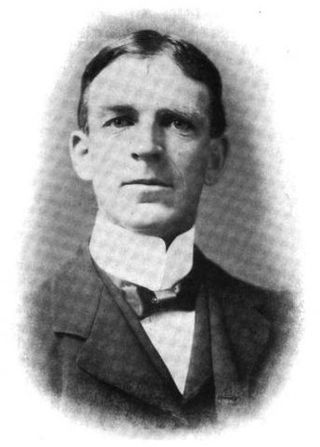
William Wallace Campbell was an American astronomer, and director of Lick Observatory from 1901 to 1930. He specialized in spectroscopy. He was the tenth president of the University of California from 1923 to 1930.
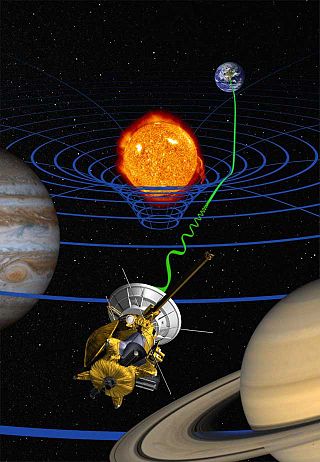
General relativity is a theory of gravitation developed by Albert Einstein between 1907 and 1915. The theory of general relativity says that the observed gravitational effect between masses results from their warping of spacetime.
Tests of general relativity serve to establish observational evidence for the theory of general relativity. The first three tests, proposed by Albert Einstein in 1915, concerned the "anomalous" precession of the perihelion of Mercury, the bending of light in gravitational fields, and the gravitational redshift. The precession of Mercury was already known; experiments showing light bending in accordance with the predictions of general relativity were performed in 1919, with increasingly precise measurements made in subsequent tests; and scientists claimed to have measured the gravitational redshift in 1925, although measurements sensitive enough to actually confirm the theory were not made until 1954. A more accurate program starting in 1959 tested general relativity in the weak gravitational field limit, severely limiting possible deviations from the theory.
General relativity is a theory of gravitation that was developed by Albert Einstein between 1907 and 1915, with contributions by many others after 1915. According to general relativity, the observed gravitational attraction between masses results from the warping of space and time by those masses.

The concept of predictive power, the power of a scientific theory to generate testable predictions, differs from explanatory power and descriptive power in that it allows a prospective test of theoretical understanding.
The Eddington mission was a European Space Agency (ESA) project that planned to search for Earth-like planets, but was cancelled in 2003. It was named for the noted astronomer Arthur Eddington, who formulated much of the modern theory of stellar atmospheres and stellar structure, popularized Albert Einstein's work in the English language, carried out the first test of the general theory of relativity, and made original contributions to the theory. It was originally planned for operation in 2008, but was delayed. The ESA website now records its status as cancelled.

Einstein and Eddington is a British single drama produced by Company Pictures and the BBC, in association with HBO. It featured David Tennant as British scientist Sir Arthur Stanley Eddington, and Andy Serkis as Albert Einstein. This is the story of Einstein's general theory of relativity, his relationship with Eddington and the introduction of this theory to the world, against the backdrop of the Great War and Eddington's eclipse observations.
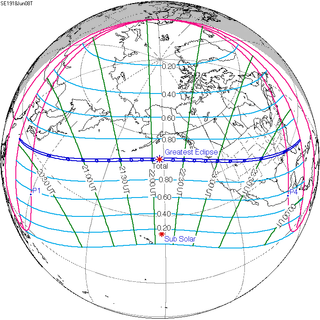
A total solar eclipse occurred on Saturday, June 8, 1918. The eclipse was viewable across the entire contiguous United States, an event which would not occur again until the solar eclipse of August 21, 2017.
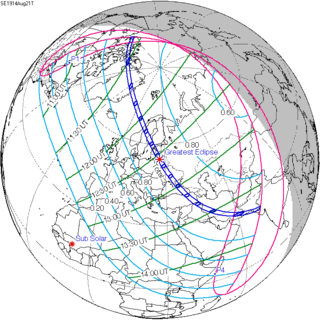
A total solar eclipse occurred on August 21, 1914. A solar eclipse occurs when the Moon passes between Earth and the Sun, thereby totally or partly obscuring the image of the Sun for a viewer on Earth. A total solar eclipse occurs when the Moon's apparent diameter is larger than the Sun's, blocking all direct sunlight, turning day into darkness. Totality occurs in a narrow path across Earth's surface, with the partial solar eclipse visible over a surrounding region thousands of kilometres wide. The totality of this eclipse was visible from northern Canada, Greenland, Norway, Sweden, Russian Empire, Ottoman Empire, Persia and British Raj . It was the first of four total solar eclipses that would be seen from Sweden during the next 40 years. This total solar eclipse occurred in the same calendar date as 2017, but at the opposite node. The moon was just 2.7 days before perigee, making it fairly large.

The Eddington experiment was an observational test of general relativity, organised by the British astronomers Frank Watson Dyson and Arthur Stanley Eddington in 1919. The observations were of the total solar eclipse of 29 May 1919 and were carried out by two expeditions, one to the West African island of Príncipe, and the other to the Brazilian town of Sobral. The aim of the expeditions was to measure the gravitational deflection of starlight passing near the Sun. The value of this deflection had been predicted by Albert Einstein in a 1911 paper; however, this initial prediction turned out not to be correct because it was based on an incomplete theory of general relativity. Einstein later improved his prediction after finalizing his theory in 1915 and obtaining the solution to his equations by Karl Schwarzschild. Following the return of the expeditions, the results were presented by Eddington to the Royal Society of London and, after some deliberation, were accepted. Widespread newspaper coverage of the results led to worldwide fame for Einstein and his theories.


